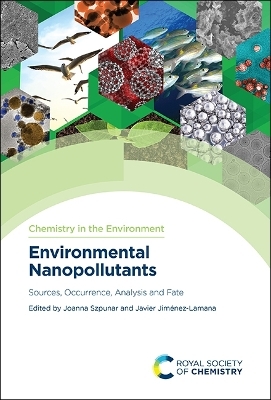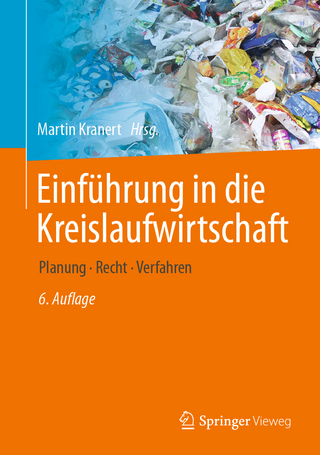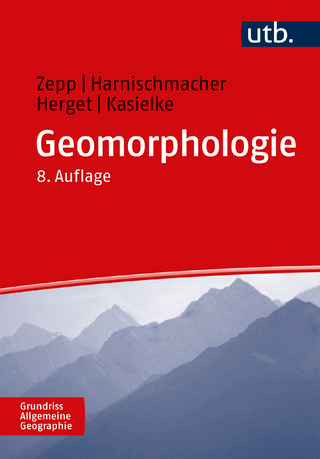
Environmental Nanopollutants
Royal Society of Chemistry (Verlag)
978-1-83916-489-7 (ISBN)
Nanopollutants are nanoparticles that have escaped into the environment and can include engineered nanoparticles as well as nanoparticles that are products of degradation (e.g. nanoplastics) or other processes. As many of these particles are only recently developed or described there is still a lot to learn about where they come from, where they end up and what risks they pose to health and the environment.
Offering a wide overview of the most recent research on these emerging contaminants, from the investigation of their sources and fate to the analytical developments for their detection and analysis, this book gives the reader a full picture of the global research on engineered and natural nanoparticles in the environment. Taking a forward-looking perspective with chapters on new nanopollutants, regulatory direction and occurrence in different environmental compartments, this book is a great resource for anyone working in environmental chemistry, nanoscience or environmental regulation.
Dr. Javier Jiménez-Lamana (M) received his PhD from the University of Zaragoza in 2014. Since 2015 he has been working at the University of Pau and Pays de l’Adour (UPPA) in Pau, France. His main research interest has been focused on the analysis of pollutants at the nanoscale in the environment. He has developed analytical methodologies based on Single Particle ICP-MS to study engineered nanoparticles in different environmental and biological matrices. Currently, he is adapting the SP-ICP-MS methodology to the detection and quantification of nanoplastics and their potential role as carriers of heavy metals. Professor Joanna Szpunar (F) graduated from the Warsaw University of Technology (Poland), received her PhD and DSc (habilitation) degrees from the University of Warsaw, and the professor title from the president of the Republic of Poland. Since 1997 she has been working at the French National Center for Scientific Research (CNRS) in Pau, France. Her research interests concern bioinorganic speciation and nanoparticle analysis and hyphenated techniques for metallomics. Joanna Szpunar authored or co-authored a book and more than 175 articles in peer reviewed journals. She gave more than 50 plenary and invited lectures at international conferences. She is fellow of the Royal Society of Chemistry and member of the Advisory Boards of Journal of Analytical Atomic Spectrometry, Metallomics and Separations. She is the laureate of the 2017 European Plasma Spectrochemistry Award.
Occurrence of ENPs and Nanoplastics in Different Environmental Compartments: An Overview;Radioactive Nano- and Microparticles Released from Fukushima Daiichi: Technical Challenges of Multiple Analytic Techniques;Biomass Burning in Southeast Asia and Influences on Atmospheric Nanoparticles;Investigation of Airborne Nanoparticles: The Focus on Analytical Chemistry;Phytoplankton Controls on the Transformations of Metal-containing Nanoparticles in an Aquatic Environment;The Composition of the Eco-corona Acquired by Micro- and Nanoscale Plastics Impacts on their Ecotoxicity and Interactions with Co-pollutants;Effects of Nanoplastics on Aquatic Organisms;Fate and Behaviour of Carbon Nanomaterials in the Aquatic Environment: A Case on Graphene and Graphene Oxide;Fate and Transport of Engineered Nanoparticles in Porous Media;
Uptake, Accumulation, and Transformation of Metal-based Nanoparticles in Plants;Interaction of Nanoparticles with Environmental Pollutants;Sampling and Pre-treatment in Nanoparticle Analysis in Water;Separation Systems Coupled to ICP-MS for the Analysis of Metal-based Nanoparticles and Colloids;Single Particle Inductively Coupled Plasma Mass Spectrometry: A Valuable Tool in Environmental Analysis;Stable Isotope Labelling and Tracing of Engineered Nanomaterials;Dosimetry and Imaging of Micro and Nanoparticles by Means of High Resolution Techniques;Imaging of Nanopollutants at a Sub-cellular Resolution by Nanoscale Secondary Ion Mass Spectrometry;Study on Behaviour and Toxicology of Nanomaterials by Synchrotron Radiation Technology;The Challenge of the Analysis of Nanoplastics in the Environment: Current Status and Perspectives;European Union Legislation Addressing Environment, Health and Safety Aspects of Nanomaterials
| Erscheinungsdatum | 28.11.2022 |
|---|---|
| Reihe/Serie | Chemistry in the Environment ; Volume 9 |
| Verlagsort | Cambridge |
| Sprache | englisch |
| Maße | 156 x 234 mm |
| Gewicht | 960 g |
| Themenwelt | Naturwissenschaften ► Biologie ► Ökologie / Naturschutz |
| Naturwissenschaften ► Chemie | |
| Technik ► Umwelttechnik / Biotechnologie | |
| ISBN-10 | 1-83916-489-1 / 1839164891 |
| ISBN-13 | 978-1-83916-489-7 / 9781839164897 |
| Zustand | Neuware |
| Informationen gemäß Produktsicherheitsverordnung (GPSR) | |
| Haben Sie eine Frage zum Produkt? |
aus dem Bereich


